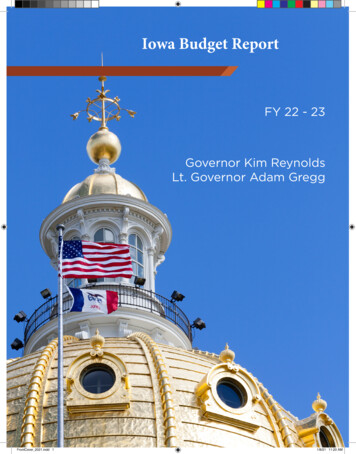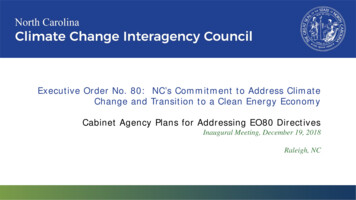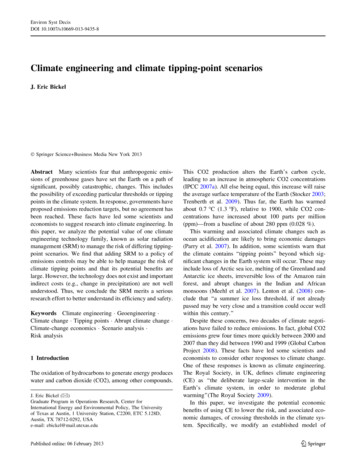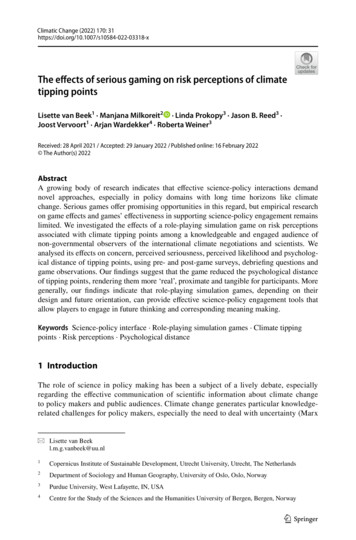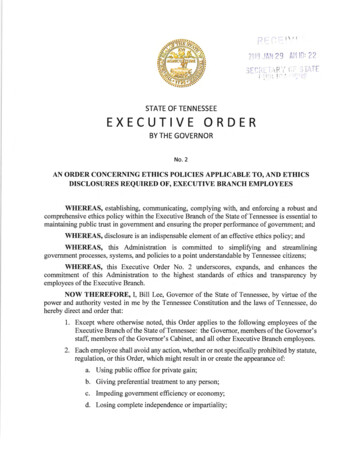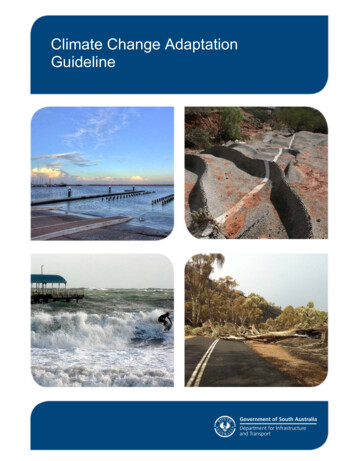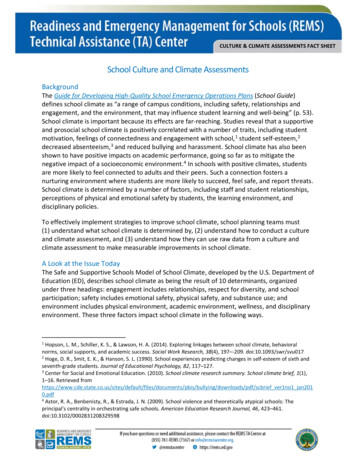
Transcription
GOVERNOR’S COMMISSION ONCLIMATE CHANGEFinal Report: A Climate Change Action PlanDecember 15, 2008The Honorable L. Preston Bryant, Jr.Secretary of Natural ResourcesChair, Governor’s Commission on Climate Change
TABLE OF CONTENTSI. Introduction. 1II. How to Interpret the Commission’s Actions on this Report. 3III. Findings. 4A. Effects on the Built Environment and Insurance . 5B. Effects on Natural Systems. 6C. Effects on Human Health. 7D. General Principles Regarding Strategies . 7E. Greenhouse Gas Reduction Goals . 10IV. Recommendations. 12A. Recommendations that affect GHG emissions. . 121. Virginia will reduce GHG emissions by increasing energy efficiency andconservation. . 122. Virginia will advocate for federal actions that will reduce net GHG emissions. . 143. Virginia will reduce GHG emissions related to vehicle miles traveled throughexpanded commuter choice, improved transportation system efficiency, andimproved community designs. . 154. Virginia will reduce GHG emissions from automobiles and trucks by increasingefficiency of the transportation fleet and use of alternative fuels. 185. Virginia will reduce GHG emissions through accelerated research anddevelopment. 196. Virginia will reduce GHG emissions by increasing the proportion of energydemands that are met by renewable sources. . 197. Virginia will reduce GHG emissions by increasing the proportion of electricitygeneration provided by emissions-free sources of energy. 218. Virginia will reduce net GHG emissions by protecting/enhancing natural carbonsequestration capacity and researching/promoting carbon capture and storagetechnology. 219. The Commonwealth and local governments will lead by example byimplementing practices that will reduce GHG emissions. 23B. GHG Reductions and Cost Effectiveness . 24i
C. Recommendations that Address Steps Virginia Should Take to Plan For and Adaptto Climate Change Impacts that are Likely Unavoidable, Including Direct AdaptiveResponses, Required Research, and Increased Capacity and Coordination WithinState and Local Government. 3210. Virginia should consider a more aggressive GHG reduction goal. . 3211. Virginia will focus and expand state capacity to ensure implementation of theClimate Change Action Plan. 3212. Virginia will educate the public about climate change and the actions necessaryto address it. . 3313. Virginia will continually monitor, track, and report on GHG emissions and theimpacts of climate change. 3414. Virginia state agencies and local governments will prepare for and adapt to theimpacts of climate change that cannot be prevented. . 3415. Virginia will undertake a thorough review of state agency and local governmentauthority to account for climate change in their actions. . 38V. Commission Deliberations. 39A. Debate on particular recommendations . 39B. Workgroups. 441. Electricity Generation/Other Stationary Sources. 442. Built Environment. 493. Transportation and Land Use. 564. Adaptation and Sequestration . 59C. Stakeholder Testimony . 64D. Public Comment. 66APPENDIX A: Members of the Governor’s Commission on Climate ChangeAPPENDIX B: Interim Reportii
FINAL REPORT OF THE GOVERNOR’S COMMISSION ON CLIMATE CHANGEA CLIMATE CHANGE ACTION PLANI. IntroductionIn September 2007, Governor Timothy M. Kaine released the Virginia Energy Plan, animplementation document designed to demonstrate how the General Assembly-enacted stateenergy policy (SB-262; Code of Virginia § 67-100) could be executed. Included in the VirginiaEnergy Plan was the recommendation that the Governor create a commission to address climatechange and its possible impacts on Virginia.Governor Kaine responded by issuing Executive Order 59 (2007), establishing the“Governor’s Commission on Climate Change.” E.O.59 charged the Commission to create aClimate Change Action Plan that would do the following:1. Inventory the amount of and contributors to Virginia’s greenhouse gas emissions, andprojections through 2025;2. Evaluate expected impacts of climate change on Virginia’s natural resources, the healthof its citizens, and the economy, including the industries of agriculture, forestry, tourism,and insurance;3. Identify what Virginia needs to do to prepare for the likely consequences of climatechange;4. Identify the actions (beyond those identified in the Energy Plan) that need to be taken toachieve the 30% reduction goal; and5. Identify climate change approaches being pursued by other states, regions, and the federalgovernment.The Commission was comprised of more than 40 citizens of the Commonwealth,including scientists, economists, environmental advocates, and representatives from the energy,transportation, building, and manufacturing sectors. The Commission also included localgovernment representatives and state lawmakers. The panel’s members were broadly expert andphilosophically diverse. The membership of the Commission is listed in Appendix A.The Commission met in full 10 times over the course of 2008, starting in February andending in December, when this Final Report was adopted. Meetings were held across theCommonwealth, often at the state’s universities, which generally had facilities that couldaccommodate the anticipated number of interested citizens who would follow the Commission’swork and want to offer comment.The Commission’s work was supported by professionals from the Department ofEnvironmental Quality, the Department of Transportation, the Department of Conservation andRecreation, the Department of Health, the Department of Agriculture and Consumer Services,and the Department of Forestry. Other experts from various state institutions of higher
education, especially Virginia Tech and the University of Virginia, were called upon for adviceor analysis.The time committed to assessing climate change’s possible impacts on Virginia, anddeveloping strategies to mitigate and combat those impacts, by the Commission members andstaff from many state agencies totaled nearly 2,000 hours. The work of the Governor’sCommission on Climate Change represents the first comprehensive global warming climatechange initiative undertaken by the Commonwealth to date.Over a six-month period, the Commission heard testimony from a variety of experts onclimate change and its impacts on the Commonwealth’s natural resources, economy, and publichealth. The Commission also heard from those knowledgeable on emerging technologies andalternative fuels that represent both strategies to reduce greenhouse gas emissions as well asopportunities for inventors and investors.The Commission issued an Interim Report in September 2008. The Interim Reportprovided an overview of the expert testimony presented to the Commission at the time of itswriting. The Interim Report neither attempted to interpret testimony presented to theCommission nor draw any conclusions from testimony. Rather, the Interim Report sought to bean objective, “straight reporting” of the Commission’s work to date. The Interim Report can befound in its entirety in Appendix B of this report.Following the Commission’s six months of foundational testimony, it deliberated over aset of findings: conclusions that the Commission had collectively drawn from the information ithad gathered. The findings are contained in section III of this report.To begin its consideration of possible recommendations, the Commission broke into fourworkgroups: Adaptation and SequestrationBuilt EnvironmentElectric Generation and Other Stationary SourcesTransportation and Land Use.These workgroups were comprised of Commission members who had expertise relevantto the subject matter each workgroup was charged with studying. Each workgroup met severaltimes, and each workgroup meeting ranged from three to five hours. A public comment periodwas held at each workgroup meeting, just as it was at each full Commission meeting. Theworkgroups developed reports explaining their recommendations; these reports were presented tothe full Commission and are summarized in section V B of this report. The workgroups were thesource of most of the more than 150 recommendation that the full Commission debated,accepted, amended, deleted, and/or adopted.The final list of recommendations, as adopted by the full Commission, is provided insection IV of this report. The list of recommendations is divided into two groups. The firstgroup consists of those recommendations that affect greenhouse gas (GHG) emissions. This first2
group of recommendations thus addresses directly the Commission’s fourth charge as outlined inExecutive Order 59: Identify the actions (beyond those identified in the Energy Plan) that need tobe taken to achieve the 30% reduction goal. After the first group of recommendations, the reportprovides estimates of the GHG reductions that will result from certain recommendations, as wellas a discussion regarding the cost effectiveness of such recommendations. The second group ofrecommendations consists of strategies that will guide Virginia’s response to climate change,including how the state should plan for and adapt to changes that are likely unavoidable. Thissecond group addresses directly the Commission’s third charge as outlined in ExecutiveOrder 59: Identify what Virginia needs to do to prepare for the likely consequences of climatechange.The time and energy put into the Commission’s work has been considerable. Everyeffort was made to meet the Commission’s charge as set forth in E.O. 59. The Commission’sfindings are clear. The Commission’s recommendations themselves are numerous, some beinggeneral and flexible where necessary and others being much more specific.The Commission appreciates Governor Kaine’s decision to create this panel and charge itwith conducting as in-depth an assessment as possible on climate change’s impact on Virginia.We urge the Governor to act quickly on those recommendations with which he concurs and forwhich no other approval is required. We further ask the Governor to direct all agency heads toreview the Commission’s final report and immediately implement those for which sufficientauthority and appropriations exist. A number of recommendations are significant and willrequire approval by the General Assembly. Legislation should be prepared for all significantrecommendations for which executive branch authority does not exist.The Commission further appreciates – and truly values – the great amount of inputprovided by the hundreds of citizens who routinely attended the panel’s meetings or otherwisesubmitted comments for the public record. We hope this report provides significant value andinsight to all who read it.II. How to Interpret the Commission’s Actions on this ReportThis final report was adopted by the Commission on a unanimous vote. In adopting thereport, Commission members endorsed the need to take actions to reduce greenhouse gasemissions and adapt to changes in Virginia’s climate. However, that unanimous vote does notreflect unanimity among Commission members on every recommendation. Instead, it means thatmost Commission members agreed with most of what is in the document. Commissionmembers’ reservations reflect the complexity of the issues that the panel faced.Testimony and presentations made before the Commission were from many perspectives.As is pointed out in the interim report, the information presented to the Commission was notnecessarily endorsed by each Commission member.3
Commission Action on the FindingsThe Commission’s findings were voted on as a set, and there was consensus support fortheir publication. Individual Commission members may have reservations about particularfindings, but all members were comfortable enough with the findings to adopt them as a whole.Commission Action on the RecommendationsThe recommendations were voted on individually, not as a set. The majority received aunanimous vote. However, certain recommendations received great debate among Commissionmembers. The report highlights those issues most intensely debated by the Commission insection V A.Difficulty in Quantifying Costs and BenefitsIt also should be noted that Commission members would have been more comfortablewith the recommendations if more quantifiable information regarding costs and benefits hadbeen available. Such analysis was not possible given the time and resource constraints on theCommission. As noted in section IV B of this report, additional analysis of cost issues will bepart of the task of implementing the report.Post-Commission Positions by Commission MembersAs noted, most Commission members are in agreement on most of what is in this report.However, Commission members are free to rely on testimony, findings, and recommendationsthat they find most persuasive and credible, as they have been throughout the Commission’syear-long deliberations. Now that the Commission’s work is complete, members will remainfree to express their own opinions on the report’s findings and recommendations as they aredebated in the future in various forums.III. FindingsThe Commission is mindful of Governor Kaine’s charge to us, and we accept his viewson certain foundational issues as our starting point. As Governor Kaine stated, the fact thatglobal climate change is happening and is largely human-caused is now widely accepted. We have used the Intergovernmental Panel on Climate Change’s (IPCC) FourthAssessment Report as our primary reference point on the science of climate change. Accordingto the IPCC, current climate models predict that global mean warming at the end of the 21stcentury (2090 - 2099) will range from 1.1 C to 6.4 C for various models and various scenarios,and the best estimate for one of the moderate emission scenarios (the so-called A1B scenario) isglobal warming of 2.8 C. Scientists from George Mason University and Center for Ocean-LandAtmosphere Studies in Maryland have examined the original IPCC data for the moderate A1B While we have concluded that the overwhelming evidence supports these points, we have heard testimonyproviding contrary information during public comment periods at our meetings.4
scenario for 15 global models and calculated the 21st century warming for Virginia and theadjoining areas (36.5 N-42 N; 73 W-84 W). They found that from 2000 to 2099 the averagewarming for Virginia and the adjoining areas would be 3.1 C (5.6 F) and that precipitationwould increase by 11%. The warming would be higher for high emission scenarios. The IPCCprojects that, to avoid catastrophic changes to the world’s climate, greenhouse gas (GHG)emissions will need to be reduced by 25% below the 1990 level by 2020, and 80% below the1990 level by 2050. While the IPCC predicts that overall changes to the world’s climate will beextremely damaging, it also acknowledges that there may be some beneficial effects for somehuman endeavors (like the growing of certain agricultural crops in certain places).As Governor Kaine noted, since climate change is a global problem, a national solution isneeded in order to achieve the most significant reductions in GHG emissions. However, becausethe effects of climate change on Virginia will be profound, we cannot wait for the federalgovernment to act. Moreover, many steps to reduce GHG emissions require state action.We believe that the actions taken by U.S. states can have a significant effect on globalGHG levels. The importance of the role of states in addressing climate change is illustrated bydata from the World Resources Institute that shows the combined emissions of Virginia, NorthCarolina, and South Carolina are equivalent to those of South Korea. GHG emissions from justsix southeastern states (Virginia, North Carolina, South Carolina, Georgia, Alabama, andTennessee) are greater than all but six countries in the world.In pursuing actions to combat climate change, Virginia is not acting in a vacuum. Indeed,we join 37 other states in preparing a climate change action plan. Based upon our review ofinformation from other Mid-Atlantic states’ climate change plans and what we have learned fromthe experts who have made presentations before the Commission, from our discussions, and fromthe many external documents we have shared with one another and posted on the Commission’swebsite, we now make the following findings:A. Effects on the Built Environment and Insurance Sea level rise is a major concern for coastal Virginia, particularly the highly populatedHampton Roads region. The Chesapeake Bay Program’s Scientific and TechnicalAdvisory Committee projects that sea levels in the Chesapeake Bay region will be0.7-1.6 meters (2.3-5.2 feet) higher by 2100. Specific impacts will vary by location,depending on changes in land elevation. Based on an analysis by RMS (a catastrophe modeling company) that has been reviewedand approved by the Organization for Economic Cooperation and Development (OECD),the Virginia Beach-Norfolk Metropolitan Statistical Area ranks 10th in the world in valueof assets exposed to increased flooding from sea level rise.5
Modeling and simulation tools already are being used to improve our understanding ofhow sea level rise and storm surge may affect certain areas of coastal Virginia. However,the fact that LiDAR (Light Detection and Ranging) elevation data does not exist for mostof coastal Virginia is a major obstacle to the ability to plan effectively for these changes. Climate changes such as sea level rise pose serious and growing threats to Virginia’sroads, railways, ports, utility systems, and other critical infrastructure. Climate change is widely viewed as a threat to national security. In Virginia, there areseveral major military installations located in low-lying areas that will be affected by sealevel rise and storm surge. The continued affordability and availability of insurance for Virginia’s landowners is aconcern as our climate changes. These effects already are being felt in coastal Virginia.The frequency and severity of storms in the future are expected to exceed those of thepast, and the insurance industry may not have the ability to handle several concurrentevents. It also is important to make sure that federal flood insurance programsdiscourage development in sensitive coastal areas.B. Effects on Natural Systems Climate change will have a significant impact on Virginia’s ecosystems. At varyingrates, vegetation ranges are moving from current locations to higher altitudes andlatitudes. The effect of this will be that suitable habitat for some species will decline,other species will become extirpated, and others species will become extinct. Climatechange also will exacerbate threats already faced by Virginia ecosystems, such asinvasive species, pathogens, and pollution. The effects of climate change on many of Virginia’s ecosystems and species will bebetter understood as more research becomes available. Research and conservation effortswill need to be increasingly focused on managing resources to maintain healthy,connected, and genetically diverse ecosystems, and plant, wildlife, and fisheriespopulations. Some of the Chesapeake Bay’s “foundation species,” such as blue crabs, eelgrass, andoysters, could decline or disappear as salinity and temperatures continue to increase andweather patterns continue to fluctuate widely from year to year. Because foundationspecies support many other species, these impacts would be felt throughout theecosystem. Oxygen levels in the Chesapeake Bay are expected to decrease due to increasingtemperatures and increasing storm runoff, which will have a negative impact on specieslike striped bass, blue crabs, and oysters. Acidification of the Bay and Atlantic Oceanalso is a concern as waters absorb more carbon dioxide (CO2).6
Coastal wetlands, a critical habitat for many of the Chesapeake Bay’s plants and animals,are being lost as sea levels rise, and freshwater coastal wetlands are similarly threatenedby saltwater intrusion. Virginia’s agriculture and forestry industries, as well as commercial and sport fishingindustries and park land, will be impacted by climate change. More research todetermine specific effects is needed. The lack of specific information on the impactshinders Virginia’s ability to adapt and prepare for these changes. Virginia’s forestlands sequester approximately 23 million metric tons of CO2 per year.Unless current land conversion trends are reversed, however, this number will declineevery year, as Virginia loses on average 27,000 acres of forestland annually todevelopment. The loss of agricultural lands, which also can sequester CO2, depending onthe management practices applied, is an additional concern. In 2003, Virginia had15.8 million acres of forestland, which represents a decline of 180,600 acres since 1992.C. Effects on Human Health Climate change is likely to have wide-ranging and mostly adverse direct and indirectimpacts on human health. Extreme weather events (e.g., floods, droughts, hurricanes orwindstorms, wildfires, and heat waves) can directly affect health through injuries,drownings, or mental health problems, among other things. These extreme weatherevents could lead to compromised water and food supplies, resulting in increases inwaterborne and food-borne illnesses. Climate change will lead to the alteration ordisruption of natural systems, making it possible for vector-borne diseases (e.g.,arthropod-borne diseases such as West Nile virus and Lyme disease) to spread or emergein areas where they previously had been limited or non-existent. These alterations ordisruptions also could result in the disappearance of some vector-borne diseases bymaking the environment less hospitable to the vector or pathogen. Climate change also isexpected to increase the incidence of diseases associated with air pollutants andaeroallergens and exacerbate other respiratory and cardiovascular conditions. The Emergency Preparedness and Response Program for Virginia is available to addressand mitigate the impacts of extreme weather events on human health and safety as well ason our buildings and infrastructure. Certain groups of people are recognized as being more vulnerable to the health impacts ofclimate change. These vulnerable populations include the following: children and theelderly, people of low socioeconomic status, members of racial and ethnic minorities,people living in coastal areas and flood plains, and people with pre-existing healthconditions and disabilities.D. General Principles Regarding Strategies It is not possible to effectively address the impacts of climate change without significantpublic and private investment. Either new funding sources, redirection of existing7
resources, or both, will be required. Actions to combat climate change should bequantifiable or meaningful and chosen in a manner cognizant of their costs and benefits.State actions should be taken in the context of national goals and strategies. Strategies that are focused on conserving existing natural carbon sinks and increasing thecapacity of those carbon sinks represent an important and cost-competitive strategy todecrease net GHG emissions. Some strategies, such as conserving land and planting treesand other vegetation, also produce a plethora of co-benefits like improving air and waterquality, providing habitat for wildlife, assisting in stormwater management, minimizingimpacts of sea level rise, producing food and fiber, reducing heat in urban areas, andproviding recreational opportunities. The three largest sources of GHG emissions in Virginia are electricity generation,transportation, and non-utility uses of fuel in industrial, commercial, and residentialfacilities. Emissions from all of these sources must be addressed in order for our climatechange mitigation efforts to be successful and fair. The nation’s movement toward a GHG emission-constrained economy represents anopportunity for Virginia researchers, inventors, and investors to accelerate and deploytechnologies in the areas of energy efficiency, indigenous renewable and low-emissionenergy, and carbon capture and storage. Fossil fuels are a significant part of Virginia’s current fuel mix. Carbon capture andstorage technology offers the potential to reduce GHG emissions while continuing toproduce energy from fossil fuels, but this technology is still in development and is notexpected to be commercially available within the next ten years. In addition, its cost,especially with regard to coal-fired electric generation, has yet to be determined. As stated in the Virginia Energy Plan, energy efficiency and conservation provide theleast costly and most readily deployable energy resource options available to Virginia. Itis essential to identify and remove fiscal, regulatory, and other barriers to investments inenergy efficiency and conservation. Many of the technologies needed to reduceemissions already are available and are becoming more affordable every day. According to the U.S. Energy Information Administration, annual per capital energyconsumption in Virginia (345 million BTU/capita, 2005 data) far exceeds Europeancountries like the United Kingdom (165 million BTU), Germany (176 million BTU),France (182 million BTU), and Italy (138 million BTU). The annual per capita energyconsumption for the United States was 1.7 percent lower than in Virginia in 2005(339 million BTU/capita). Virginia ranks 27th highest of the states and District ofColumbia. States ranged from 1,194 million BTUs/capita in Alaska and 912 millionBTUs/capita in Wyoming, down to 217 million BTUs/capita in New York and213 million BTUs/capita in Rhode Island. Based on 2008 load forecast projections from the PJM Interconnection, the organizationthat manages the regional power grid of which Virginia is a member, electricity demand8
is projected to grow by 26.8% in the part of Virginia served by Dominion Virginia Powerand 14.7% in the part of Virginia served by Appalachian Power over the next 15 years.(See table below.)In calculations completed during development of the Virginia Energy Plan, the VirginiaDepartment of Mines, Minerals and Energy (DMME) projected that natural gasconsumption will grow 3.6% from 2007 through 2016 under a business as usual scenario.Natural gas increasingly is being used for electric generation because it is the cleanest ofthe fossil fuels. This may cause an increase in demand for natural gas supply above thisBAU projection.The Virginia Energy Plan states that efficiency and conservation efforts should beaccelerated to reduce these projected growth rate increases. The Plan further states that,even with increased conservation, new electricity generation capacity will be needed.How Virginia supplies this electricity will have a bearing on the Commonwealth’s GHGemissions.15-YearGrowth RateProjectionDominionAEPkWHSummer kWPeakWinter %0.7%11.3%Annual15-YearAnnual15-Year While recently-enacted federal fuel efficiency standards will reduce the level of GHGsthat otherwise would be emitted by automobiles, if there is a significant increase invehicle miles traveled (VMT), that would mean that transportation emissions still wouldgrow over time. Regardless of the rate of VMT change
Commission on Climate Change represents the first comprehensive global warming climate change initiative undertaken by the Commonwealth to date. Over a six-month period, the Commission heard testimony from a variety of experts on climate change and its impacts on the Commonwealth's natural resources, economy, and public health.
